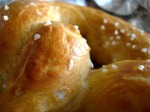With record-breaking highs in the triple digits, this year already feels like summer. Let me be the first to say…. I HATE SUMMER! Especially in the desert! It’s too hot, too sunny, too sweaty. I just can’t take it. On Saturday, I actually went into our pool. OUR POOL! ON APRIL 21ST! That’s so unnecessary. I even have a tan line…
Sad.
Well, regardless of my deep hatred of summer (spring and fall, you’re the only ones for me!), with it being so summery outside I just had to bake something to fit this crazy weather. I thought about this summery peach tart, but on my morning trip to the supermarket saw this lovely little pineapple on sale. And after over 3 years of the wonderful BF asking me to pretty please make his favorite dessert, I finally caved.
Ain’t she cute? This picture was taken right after she saw the knife and realized she was going to meet her maker… Don’t look so surprised, Ms. Pineapple, we both knew this day was coming… don’t worry, you are dying for a noble cause: Thomas Keller’s pineapple upside down cake recipe. BF walked into the kitchen and saw my Ad Hoc book out, “Ooh, Thomas Keller? Didn’t realize you were going gourmet for me.” Of course, dear. For you, I pull out all the stops. 🙂
No, those aren’t specks of dirt in there, Thomas Keller’s recipe calls for vanilla bean paste, which contains little flecks of vanilla bean seeds. You can substitute 1:1 for vanilla extract though, no big deal. Even if you don’t use it for this recipe, though, I highly recommend you find yourself some vanilla bean paste… I could eat that stuff straight out of the jar. It’s simply delightful.
Pictures in this post are courtesy of BF’s fancy pants new iPad. He was my honorary photographer, as he was explaining to me how his iPad camera actually has a higher resolution than our DSLR… ha!
Pineapple Upside Down Cake
[ Printable Recipe ]
Pan Schmear
· 8 tablespoons (1 stick; 4 ounces) unsalted butter, at room temperature
· 1 1/2 tablespoons honey
· 1/2 teaspoon dark rum (I used bourbon, it’s all I had)
· 1 cup packed dark brown sugar
· 1/4 teaspoon pure vanilla extract
· Kosher salt
· 1 Gold (extra sweet) pineapple
Cake
· 1 1/2 cups cake flour
· 2 teaspoons baking powder
· 8 tablespoons (1 stick; 4 ounces) unsalted butter, at room temperature
· 1/2 cup plus 2 tablespoons granulated sugar
· 1/2 teaspoon pure vanilla extract
· 2 large eggs
· 1 tablespoon plus 1 teaspoon milk
Preheat the oven to 350°F.
1. In the bowl of a stand mixer fitted with the paddle, combine the butter, honey, rum, brown sugar, and vanilla and beat until smooth and well blended. Spread 1/3 cup of the schmear over the bottom of a 9-inch baking pan. Sprinkle lightly with salt. (The remaining schmear can be refrigerated for up to 2 weeks or frozen for up to 1 month; bring to room temperature before using.)
2. Cut the top and bottom from the pineapple and cut away the peel. Cut the pineapple lengthwise into quarters, and cut off the core from each section. Cut each piece into 1/8-inch-thick slices. Beginning at the perimeter of the pan, make an overlapping ring of pineapple slices with the curved side facing out. Make a second ring inside the first one, overlapping the slices in the opposite direction, working toward the center of the pan. Reserve any extra pineapple for another use.
3. Sift the flour and baking powder together; set aside.
4. Put the butter and sugar in the bowl of a stand mixer fitted with the paddle and mix on low speed to combine, then beat on medium speed for about 3 minutes, until light and creamy, stopping to scrape down the sides as necessary. Mix in the vanilla. Add the eggs one at a time, beating until the first one is incorporated before adding the second and scraping down the sides as necessary. Beat in the milk. Add the flour mixture in 3 batches, beating until just combined.
Pour the batter into the pan and spread over the pineapple.
5. Bake for 15 minutes. Rotate the pan for even browning and bake for another 20 to 25 minutes, until a cake tester or wooden skewer inserted in the center of the cake comes out clean. Cool the cake in the pan on a cooling rack for 20 to 30 minutes.
6. Run a knife around the edges of the cake, invert onto a serving platter, and serve warm. (Leftover cake can be stored at room temperature for up to 2 days.)
[ Adapted from Ad Hoc at Home, by Thomas Keller ]


























